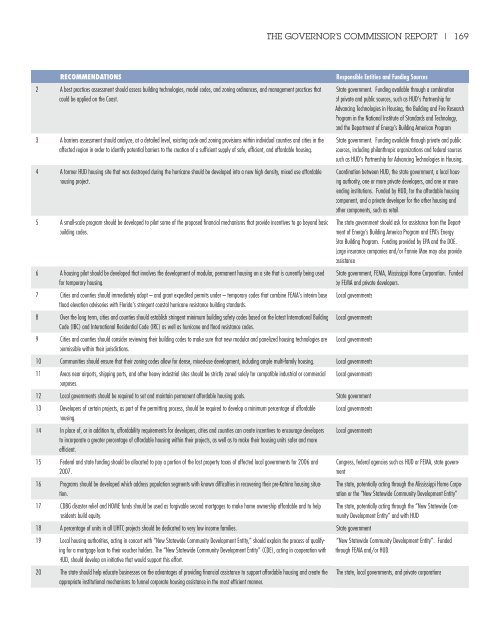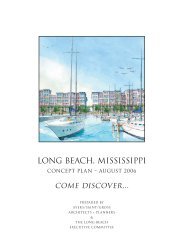Reports - Mississippi Renewal
Reports - Mississippi Renewal
Reports - Mississippi Renewal
- No tags were found...
You also want an ePaper? Increase the reach of your titles
YUMPU automatically turns print PDFs into web optimized ePapers that Google loves.
THE GOVERNOR’S COMMISSION REPORT | 169RECOMMENDATIONS2 A best practices assessment should assess building technologies, model codes, and zoning ordinances, and management practices thatcould be applied on the Coast.3 A barriers assessment should analyze, at a detailed level, existing code and zoning provisions within individual counties and cities in theaffected region in order to identify potential barriers to the creation of a suffi cient supply of safe, effi cient, and affordable housing.4 A former HUD housing site that was destroyed during the hurricane should be developed into a new high density, mixed use affordablehousing project.5 A small-scale program should be developed to pilot some of the proposed fi nancial mechanisms that provide incentives to go beyond basicbuilding codes.6 A housing pilot should be developed that involves the development of modular, permanent housing on a site that is currently being usedfor temporary housing.7 Cities and counties should immediately adopt – and grant expedited permits under – temporary codes that combine FEMA's interim basefl ood elevation advisories with Florida's stringent coastal hurricane resistance building standards.8 Over the long term, cities and counties should establish stringent minimum building safety codes based on the latest International BuildingCode (IBC) and International Residential Code (IRC) as well as hurricane and fl ood resistance codes.9 Cities and counties should consider reviewing their building codes to make sure that new modular and panelized housing technologies arepermissible within their jurisdictions.Responsible Entities and Funding SourcesState government. Funding available through a combinationof private and public sources, such as HUD's Partnership forAdvancing Technologies in Housing, the Building and Fire ResearchProgram in the National Institute of Standards and Technology,and the Department of Energy’s Building American ProgramState government. Funding available through private and publicsources, including philanthropic organizations and federal sourcessuch as HUD's Partnership for Advancing Technologies in Housing.Coordination between HUD, the state government, a local housingauthority, one or more private developers, and one or morelending institutions. Funded by HUD, for the affordable housingcomponent, and a private developer for the other housing andother components, such as retail.The state government should ask for assistance from the Departmentof Energy’s Building America Program and EPA’s EnergyStar Building Program. Funding provided by EPA and the DOE.Large insurance companies and/or Fannie Mae may also provideassistanceState government, FEMA, <strong>Mississippi</strong> Home Corporation. Fundedby FEMA and private developers.Local governmentsLocal governmentsLocal governments10 Communities should ensure that their zoning codes allow for dense, mixed-use development, including ample multi-family housing. Local governments11 Areas near airports, shipping ports, and other heavy industrial sites should be strictly zoned solely for compatible industrial or commercialpurposes.Local governments12 Local governments should be required to set and maintain permanent affordable housing goals. State government13 Developers of certain projects, as part of the permitting process, should be required to develop a minimum percentage of affordablehousing.14 In place of, or in addition to, affordability requirements for developers, cities and counties can create incentives to encourage developersto incorporate a greater percentage of affordable housing within their projects, as well as to make their housing units safer and moreeffi cient.15 Federal and state funding should be allocated to pay a portion of the lost property taxes of affected local governments for 2006 and2007.16 Programs should be developed which address population segments with known diffi culties in recovering their pre-Katrina housing situation.17 CDBG disaster relief and HOME funds should be used as forgivable second mortgages to make home ownership affordable and to helpresidents build equity.Local governmentsLocal governments18 A percentage of units in all LIHTC projects should be dedicated to very low income families. State government19 Local housing authorities, acting in concert with “New Statewide Community Development Entity,” should explain the process of qualifyingfor a mortgage loan to their voucher holders. The “New Statewide Community Development Entity” (CDE), acting in cooperation withHUD, should develop an initiative that would support this effort.20 The state should help educate businesses on the advantages of providing fi nancial assistance to support affordable housing and create theappropriate institutional mechanisms to funnel corporate housing assistance in the most effi cient manner.Congress, federal agencies such as HUD or FEMA, state governmentThe state, potentially acting through the <strong>Mississippi</strong> Home Corporationor the "New Statewide Community Development Entity"The state, potentially acting through the “New Statewide CommunityDevelopment Entity” and with HUD“New Statewide Community Development Entity”. Fundedthrough FEMA and/or HUD.The state, local governments, and private corporations




